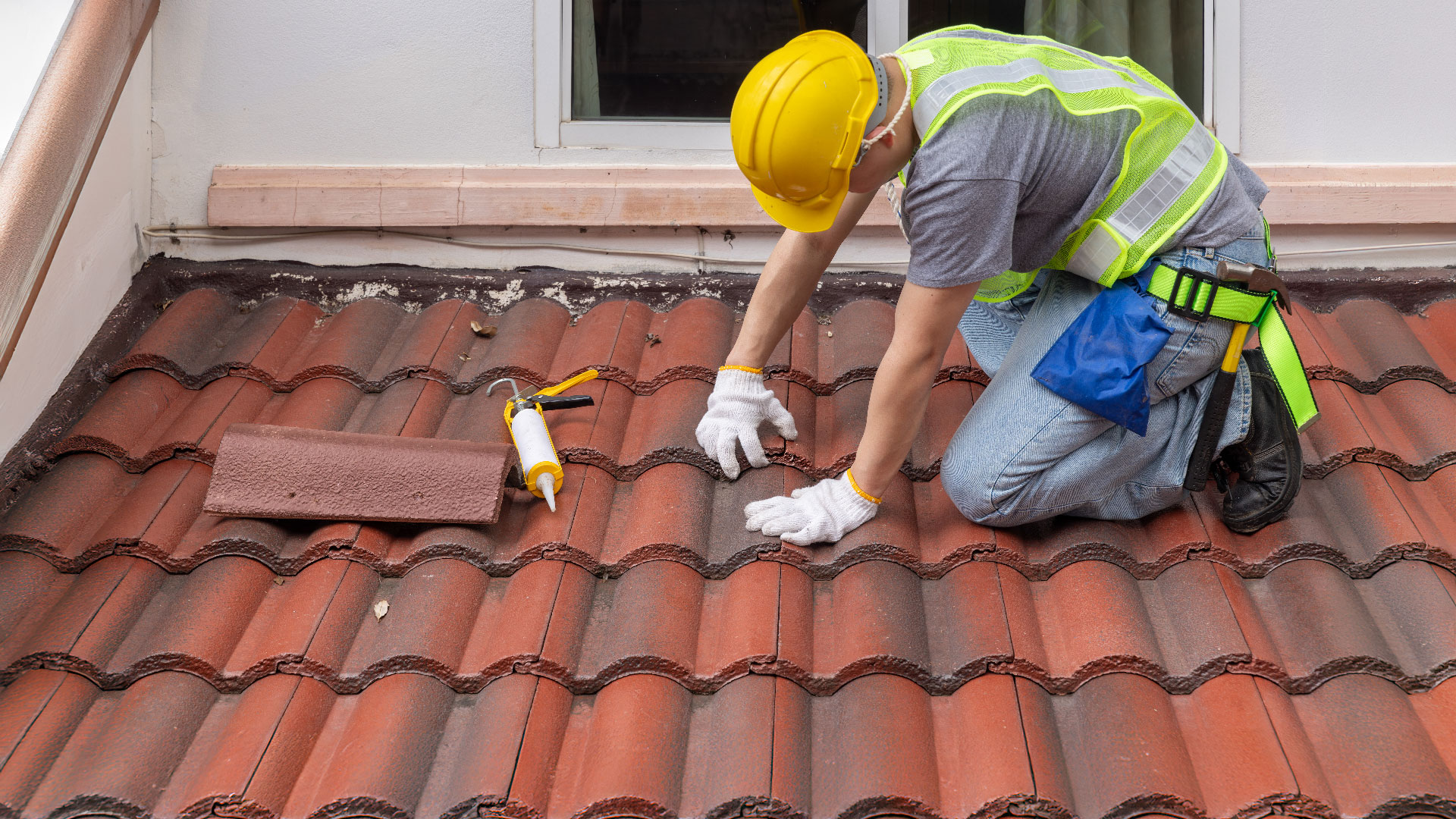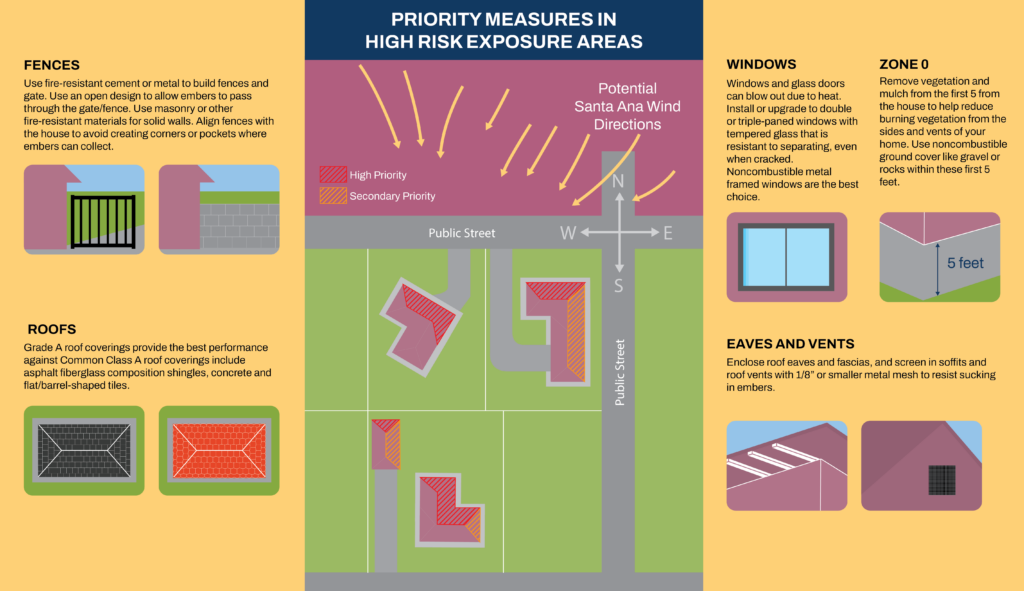
Building a Resilient Building
Make your building more resilient against future fires by considering how embers and small flames could ignite your building. Proactive action to build a resilient building or retrofit an existing building can help to reduce risk from wildfires or building to building fires.
Resilient Buildings
Research around building destruction vs. survival in wild-to-urban fires points to embers and small flames as the leading cause of ignition. Embers are burning pieces of airborne wood and/or vegetation particles that can be carried more than a mile by the wind. They can cause spot fires and ignite buildings, debris, and other objects. A combination of Firewise construction and landscaping, and community-scale practices, can help buildings withstand windblown embers by minimizing the likelihood of flames touching a building or any attachments and reducing the chance of fire spreading.
Property owners outside of High Fire Hazard Severity Zones may want to consider going beyond what the building code requires. Chapter 7 of the LA County Building Code outlines materials and constructions methods for exterior fire exposure that you may want to consider incorporating into your rebuild, and that are discussed below.
To review Cal Fire’s proposed updated Fire Hazard Severity Zones, please see this comparison map, which allows you to look at the current zones and proposed zones. State law requires Los Angeles County to adopt the recommended maps by ordinance within 120 days of their issuance, which was March 24, 2025. For a description of the adoption process and to submit public comments, please visit the Los Angeles County Fire Department Defensible Space website here.
* NOTE: The California Fire Code is currently being updated and will take effect July 1, 2025. The Los Angeles County Fire Code will become effective January 1, 2026.
Roofs
Roofs are highly vulnerable parts of a building during fires due to the large surface areas.
Use Grade A roof covering materials. Grade A roof coverings provide the best performance against fires. Common Class A roof coverings include asphalt fiberglass composition shingles, standing seam metal, clay, concrete and flat/barrel-shaped tiles. Different choices provide greater longevity, recyclability, and lower transportation costs.
Though in some limited cases the County’s cool roof requirements (sources: ordinance and technical fact sheet) may be waived—i.e., only in the unincorporated area of the Eaton Fire impacted area, and only if a “like-for-like” rebuild—it is still possible to meet this requirement with a Class A Roof, and it is encouraged to do so for the additional building occupant comfort and energy usage benefits. Please discuss this critical material choice with your team. Please also see available resources and incentives.
Consider a simple shape. Additional architectural details can add additional surfaces, nooks, and corners where embers can collect.
Study your roof’s aspect ratio. If the widest exterior of the structure faces the direction from which a fire is likely to come, it will be more vulnerable. More fire-resistive materials may be needed on the side that faces oncoming fire.
Enclose Eaves. Enclose roof eaves and fascias, and screen in soffits and roof vents with 1/8” or smaller metal mesh to resist sucking in embers. Note: There are roof assemblies that can meet all code requirements without needing to be vented, which may also be more energy efficient and healthier assemblies.
Maintain your roof. Keep your roof clear of debris and vegetation, including gutters (which should also be screened/have guards), solar panel attachments, and corners.
Sides
The sides of buildings are vulnerable to ember cast and radiant heat from burning structures, vegetation, or other highly flammable items like cars parked on a driveway. Invest in sealing air leaks to prevent smoke infiltration and reduce the chance of embers entering a building.
Vents: Use baffled vents or install metal mesh screens with a maximum opening of 1/8 inch to all exterior vent openings to prevent embers from entering attics, crawlspaces, or HVAC ducts. Note: There are crawl space assemblies that can meet all code requirements without needing to be vented, which may also be more energy efficient and healthier assemblies.
Upgrade Windows and Doors: Windows and glass doors can blow out or break due to heat. Install or upgrade to double or triple-paned windows with tempered glass that is resistant to separating, even when cracked. Integrating fire shutters or metal mesh screening over glazing are additional options. Noncombustible metal framed windows are the best choice.
Use Fire-Resistant Siding, Roofing & Insulation: Choose siding and roofing materials that are fire resistant. Use insulation that is fire resistant such as cellulose or rockwool, not fiberglass or foam. Other earthen and natural materials, such as lime plaster siding or straw bale and hempcrete insulation can also provide fire resistance.
Install Gutter Guards: Choose noncombustible gutter guards that shed leaves and needles while still letting water through rather than letting leaves and needles accumulate. This reduces maintenance needs of clearing flammable debris from the roof/sides systems of a building.
Add a facade: Adding a 5-foot exterior wall made of fire-resistant materials (e.g. brick, hempcrete, cob, strawbale, rammed earth) to all perimeter walls may keep embers from damaging the sides of homes.
Surroundings
How you and your neighbors maintain plants and place structures and equipment around a building can also help reduce risks from fires.
Clear the First Five Feet (Zone 0): In this most important ember-free or ember-resistive zone, it is essential to keep the area clear to prevent embers from igniting materials that can spread fire to your building and other buildings. Remove vegetation and mulch from the first five (5) feet from the building to help reduce burning vegetation from the sides and vents. Use noncombustible ground cover like gravel or rocks within these first five (5) feet. This action is an inexpensive and effective way to make a building more resilient. Other material choices, such as permeable pavers or sand-set pavers, can also allow rainwater to percolate into the soil. Additionally, installing more than six (6) inches of noncombustible material on the exterior building’s walls, measured from the ground or nearest horizontal surface, further limits ember ignition.
Enclose Under Decks: Use mesh screens with a maximum opening of 1/8 inch to enclose the area under decks so embers do not fly under and collect. Do not store combustible materials (i.e., firewood, plastic furniture, etc.) underneath the deck.
Build Fire-resistant Fences/Walls: Use masonry walls or metal fencing material to help direct flames from structures and reduce fire from traveling along a fence. This is especially important for fences attached to a structure.
Cut Fuel Bridges: Use masonry or metal barriers to separate decks, fences, porches, and outbuildings made with combustible materials from the building. For more information on landscaping and the outdoors, i.e., native and fire-resistant plants, maintenance, etc., please see Landscaping & Outdoors.
Maintenance: Remove dead or dried vegetation from your property. Regularly remove accumulated leaves or debris from your property. Flammable items, such as propane tanks, should be stored properly and away from any structure.
Community
Building hardening and defensible space become exponentially more effective when it is done at a larger scale. Neighbors can help to protect their block by making sure each building is proactively reducing fire risk.
Share Information: Connect with your neighbors and share this information on how to make buildings more resilient to fires.
Sign up for consultations: The Resource Conservation District of the Santa Monica Mountains offers a free Home Ignition Zone Evaluation Program. Fire Safe Councils offer consultations for homeowners on defensible space, home hardening, and/or landscaping.
Be prepared: Use the Ready! Set! Go! brochure from the LA County Fire Department to help create defensible space around a building, retrofit buildings with fire-resistant materials (Source 1, 2), and prepare to safely evacuate during a natural disaster. No structure or building can be fully protected, so it is important to always be prepared.
Santa Ana Winds and Fire
Properties highly impacted by the Santa Ana winds should take extra precautions in hardening buildings and properties along high-risk exposure areas as winds blow southwest towards the coast. Focusing on hardening and safeguarding vulnerable elements, such as vents, windows, or fencing, can help better protect structures from strong winds, dust, smoke, and wind-driven fire storms.

